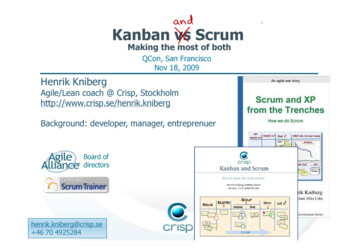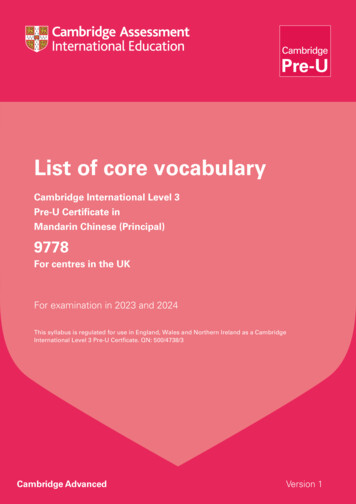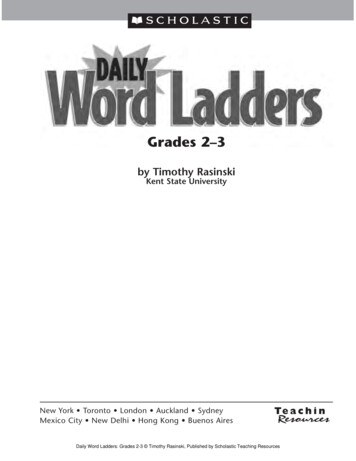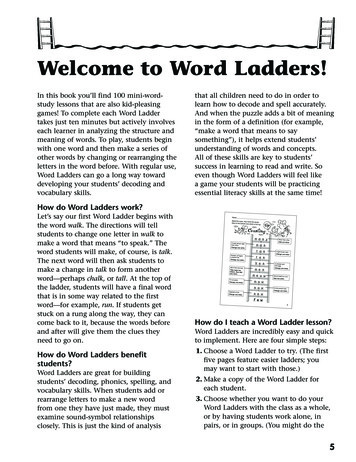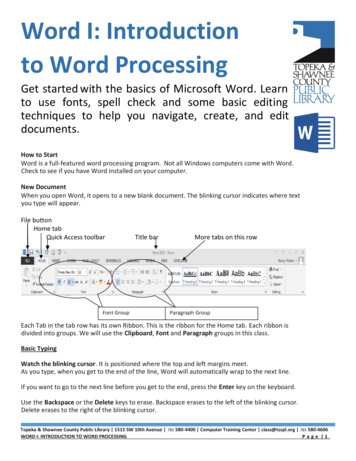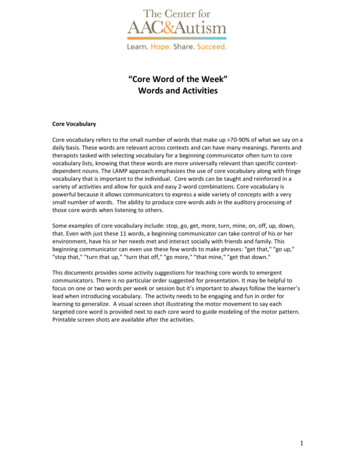
Transcription
“Core Word of the Week”Words and ActivitiesCore VocabularyCore vocabulary refers to the small number of words that make up 70-90% of what we say on adaily basis. These words are relevant across contexts and can have many meanings. Parents andtherapists tasked with selecting vocabulary for a beginning communicator often turn to corevocabulary lists, knowing that these words are more universally relevant than specific contextdependent nouns. The LAMP approach emphasizes the use of core vocabulary along with fringevocabulary that is important to the individual. Core words can be taught and reinforced in avariety of activities and allow for quick and easy 2-word combinations. Core vocabulary ispowerful because it allows communicators to express a wide variety of concepts with a verysmall number of words. The ability to produce core words aids in the auditory processing ofthose core words when listening to others.Some examples of core vocabulary include: stop, go, get, more, turn, mine, on, off, up, down,that. Even with just these 11 words, a beginning communicator can take control of his or herenvironment, have his or her needs met and interact socially with friends and family. Thisbeginning communicator can even use these few words to make phrases: "get that," "go up,""stop that," "turn that up," "turn that off," "go more," "that mine," "get that down."This documents provides some activity suggestions for teaching core words to emergentcommunicators. There is no particular order suggested for presentation. It may be helpful tofocus on one or two words per week or session but it’s important to always follow the learner’slead when introducing vocabulary. The activity needs to be engaging and fun in order forlearning to generalize. A visual screen shot illustrating the motor movement to say eachtargeted core word is provided next to each core word to guide modeling of the motor pattern.Printable screen shots are available after the activities.1
IndexCore VocabularyStop Go Turn Get .Up & Down Open & Close .On In .Off Make .Fast & Slow Play .Push Do Say .Put .Like .That Interjections Colors Feelings .Have .Give Look .Move Big & Little My/Mine . .More .Need .Read .Want .Core Word Activities3, 604, 615, 626, 637, 64, 658, 66, 679, 6810, 6911, 7012, 7113, 72, 7314, 7415, 7516, 7617, 7718, 7819, 7920, 8021222324, 8125, 8226, 8327, 8428, 85, 8629, 87, 8830, 8931, 9032, 9133, 92Swing .Music .Cars .Coloring Trampoline .Snack .Bubbles .Blocks .Chasing .Cooking .Ball Balloons . .Animals . Marbles . Play-Doh .Dress up . .Tops .Sensory bins .Videos Riding in cars .Board games . .Trick-or-Treat . . Reading .Videogames . .Mealtimes . .Silly Social Play. 8592
StopFew words in our language are as powerful as the word “stop.” Above all other linguisticfunctions, this word clearly expresses protest. Many children with autism are without afunctional, socially appropriate means of expressing protest and turn to aggression and selfinjurious behaviors to object to people, occurrences and objects in their immediateenvironment.Set up situations in which your child can use the word “stop” to tell an adult or peer todiscontinue an activity. Try pressing piano keys while your child is attempting to play, stand infront of the television, block the computer monitor or attempt to steal the child’s toy. Prompthim or her to say “stop,” then immediately discontinue the “annoying” behavior. Theseexercises should of course be done with extreme caution and limited frequency; don’toverwhelm or frustrate your child.“Stop” is a great word for children to use to request that an activity be over. Early stages of AACintervention are often most successful while following a child’s lead, so when the child appearsto be ready discontinue an activity, have them request to “stop” their current activity beforemoving on.Some children with autism are very interested in transportation. When traveling in the car, orlooking out a window, cars, buses, trucks and trains are great topics for children to comment onusing the word “stop.”Many children love to be able to control their environment and the behavior of others. Engageyour child with silly dancing, running, jumping and movement and then prompt them to tell youto “stop.” Exaggeratedly “stop” moving by freezing your whole body or even by falling down.Using “stop” to direct the behavior of others may be a great way to involve a family pet ortherapy dog.STOP & GO : “Stop” pairs easily with “go” for many movement-related activities. Try using“stop” while swinging, bouncing, jumping and other sensory/motor activities. In classroom andgroup therapy activities, allow the child to direct music and movement activities using “stop”and “go.” Other things that can both “stop” and “go” are music, videos, fans and moving toys.STOP THAT/STOP IT: “That” and “it” are great words for communicators at the 2-word level topair when protesting.3
GoThe word “go” has so many meanings and uses in English that it can be applied in almost anyactivity. The most obvious applications are those involving movement (bouncing on a ball,swinging, jumping on a trampoline, running). The word “go” also comes with a built-in sociallyrelevant verbal prompt: “ready set .”For children who are motivated by moving toys, bubbles, videos and music, “go” is a great wordfor them to ask for initiation.Many children enjoy being able to control the behavior of other people. The word “go” canempower a child to direct his peers to “go” during dancing/movement games, tell an adult to doa somersault, tap dance or make silly faces. The child using the device can direct music to “go”during a game of musical chairs or to initiate a relay race.Remember that core words are relevant for many communicative functions! Let a child protestyour involvement in an activity by telling you to “go” away or allow him or her to comment onsomeone else’s activity (if someone walks out of the room, he/she may say “go”).COME & GO – Sneak up or run up to the child when he/she says “come,” then leave whenhe/she says “go.”STOP & GO – Most activities that can “go” can also “stop.” Play and pause music and videos,make a fan “stop” and “go.”GO UP/DOWN – Physical activities like climbing and sliding are great opportunities to teach theprepositions. Many preschool toys have slides, ramps and chutes for action figures, cars andballs to “go up” and “go down.”Be creative! Remember to follow the child’s lead and help him/her find appropriate vocabularyto request, comment, protest and direct.4
TurnLook up “turn” in the dictionary and you may find over 100 different uses!“Turn” is a great word to talk about any activity or object that rotates or spins. Engage your childin play with spinning toys by making them “turn” and stop.Engage in fun dancing activities in the classroom and let the child direct students or teachers to“turn” while dancing. Many children like to be spun on the swing; allow them to direct you bysaying “turn me” “turn it” or “turn swing.”“Turn” is a very relevant word to use with any activity or object with an on/off switch or volumecontrol. Model using phrases like “turn it on” or “turn that up” when playing with toys, listeningto music or watching videos. Allow your child to object to songs or shows that he or she doesn’tlike by saying “turn that off” asking to “turn down” the volume.Have some fun gently sabotaging your child’s routine by “turning” their clothes inside out,holding a book backwards or offering them a cup upside down. Help them problem-solve thesesilly situations and tell you to “turn” them. Other problem-solving activities can involve a childdirecting you to “turn” a key to access a locked room or “turn” a screwdriver to replace deadbatteries.Because one meaning of the word “turn” is to change directions, it is a great word for kids to useto control movement activities. Pull your child on a wagon or push them on a scooter, thenchange directions when they direct you to “turn.” Model the use of the word when riding in thecar or watching traffic from the window to describe the movement of cars, trucks and buses.Allow your child to control the pace while reading books or looking at photo albums by tellingyou to turn the page.One of the most popular applications of the word “turn” in school and intervention programs isfor turn-taking during game play. This is a great opportunity for your child to learn pronouns like“my,” “your,” “his” and “her,” so be sure that your child’s device allows him or her theopportunity to combine pronouns with “turn,” instead of having one button say “my turn” or“your turn.”5
GetThe word “get” pairs nicely with nouns, pronouns and prepositions for so many differentcommunicative functions. Children can say phrases like: “get up,” “get in,” “get that,” “get me,”“get wet,” “get on” “get mom,” and “get silly” in many fun activities.A child who loves to be chased and tickled may very quickly learn to use the 2-word combination“get me” to initiate rough and tumble play. After catching and tickling your child, continueteaching pronouns by saying “I got you” while modeling on his/her device. During recess orgroup play dates, encourage your child to initiate chasing games to “get” his/her peers.“Get” can be a powerful word for a child to use to request items that are out of sight or out ofreach. Teach your child to use “get it” or “get that” and he or she can direct you retrievepreferred toys or food items. During classroom routines, model the use of “get” when directingchildren to prepare for activities (e.g., “get” your books, “get” your coats). We can use “get” toaccess people as well; a child can ask an adult to “get mom” or “get” a peer or sibling.Pair “get” with prepositions during movement play. Try creating an obstacle course in whichyour child must “get down” to crawl under a barrier, “get in” and “get out” of a tunnel or ballpit, “get over” a barrel, “get on” and “get off” therapy ball and then “get up” a set of stairs. Letyour child direct you or his/her peers when it is their turn to do this activity. “Get up” is a greatphrase to use after sitting on the floor, falling down or pretending to sleep.The word “get” can be used to mean “become.” Have fun talking about and learning emotionsand basic concepts by modeling and prompting phrases like “get happy,” “get tired,” “get silly”or “get wet.”6
Up & DownThe prepositions “up” and “down” have meanings beyond simple directions. We can “get up,”“clean up,” “stay up,” “blow up,” “fall down,” “lie down,” “sit down” and “slow down.”Gently sabotage music, TV and computer activities by adjusting the sound volume. Have yourchild direct you to turn it “up” or “down.” Lights can also be turned “up” and “down.” A childwho can ask for undesired sounds to be turned “down” or for lights to be turned “up” isempowered to modify his/her environment to a more comfortable sensory level.Let a child ask you to retrieve specific toys from a shelf by asking for them to be put “down,”then when the child is done playing, you can put the toys “up.”“Up” and “down” are great words to use when doing gross motor activities. Talk about going“up” and “down” stairs, jumping “up” and “down” or even rolling a barrel or a ball “up” and“down” a large wedge or hill. A child can asked to be picked “up” or put “down.”Many songs and word plays use the words “up” and “down.” Let your child fill-in-the-blanks forRing-Around-the-Rosy, Itsy Bitsy Spider, and the Wheels on the Bus.Help your child use prepositions to ask to be picked “up” and put “down” and describe falling“down” and getting “up.”Many of your child’s favorite activities may easily use the words “up” and “down:” car race toys,videos of rollercoasters, dollhouses with stairs, building blocks/Legos, or blowing bubbles.7
Open & CloseOpposites “open” and “close” are great words to target in a variety of activities. We can “open”and “close” so many things in our environment: eyes, toys, boxes, drawers, containers, laptops,windows, window shades/blinds, refrigerators, books, mailboxes, envelopes, new toys,presents, drawers, hands, water bottles, folders, purses, nail polish, gates, computerprograms,etc! A ride in the car is a great opportunity to use the words “open” and “close.” Youand your child can talk about “opening” and “closing” the car doors, windows, glovecompartments and even the AC vents.Try working on “open” during mealtimes as an alternative way to request a favorite food; handyour child his/her favorite food in a difficult-to-open container and prompt them to direct you toopen it. Have your child participate in food preparation or clean-up by having them “open” and“close” the refrigerator, cupboards, pantry or dishwasher. Model the word “open” when using acan opener and “close” when sealing food items.Use computer-based activities to teach these words by “opening” and “closing” a laptop, CDROM drive, game jewel cases and browser windows. Favorite games or computer accessoriesthat are kept in a drawer or file can be accessed using the word “open.”Gently sabotage your child’s routines by placing favorite toys inside of locked drawers ordifficult-to-open containers (e.g., large pretzel jars or canning jars with a metal clamp) andprompt them to direct you to “open” it. Leave a normally “closed” door “open” and have yourchild direct you to “close” it.Have fun making silly faces by letting your child direct you to “open” and “close” your eyes, noseand mouth.8
OnThe word “on” is relevant in so many contexts: traveling (“on” a bus), mealtimes (putting food“on” a plate), playing (“on” the computer) and dressing (putting “on” clothes).We use the word “on” frequently to discuss locations. Allow your child to direct you or peers tosit “on” a chair, put something “on” a table or shelf or stand “on” a stool. Your child could take aturn giving directions during a game of Twister (e.g., “foot on red”).Allow your child to direct you or make choices about art activities: color “on” the paper, putglitter “on” the page, and paint “on” the canvas.The word “on” can be used to describe traveling – we can ride “on” a bus, “on” a train, “on” anairplane, “on” a bike, “on” a horse or even “on” someone’s shoulders.Let your child help set the table at mealtimes by putting plates and utensils “on” the table, food“on the plates and salt “on” the food.Have fun being silly while learning about body parts by putting play-doh or stickers “on” yourchild’s nose, knee or elbow. Continue with silly dress-up games and put “on” shoes, dresses,wigs, hats and even make-up or face paint.Many things in your child’s environment have on/off switches: computers, lights, toys,flashlights, kitchen appliances, TVs, radios, cars, fans, water faucets. Use these motivating androutine activities to teach the word “on.” As your child’s language grows, add some more corewords to say “turn it on.”9
In“In” is another frequently-used preposition that can be used in so many contexts. We can go“in” a room, put our foot “in” our shoe, pour juice “in” a cup, crawl “in” a tunnel, put a CD “in” aCD player, and get “in” bed.During transitions around school or in the community, talk about getting “in” the car, going “in”the doctor’s office, walking “in” the store, going “in” the classroom, sitting “in” the chair andgoing “in” the therapy room.While getting dressed, you can play a silly game while learning about body parts; put your child’shand “in” his /her shoe instead of his/her foot, then have him/her correct you and tell you toput his/her foot “in.” Do the same thing with your child’s arm “in” pants, leg “in” a shirt andeven head “in” underwear!During clean-up time, “in” is a very frequently used word. Have your child direct you or peers toput toys, clothes, dishes, etc. “in” a box, “in” the drawer, “in” the bag, “in” their backpack or “in”the closet.Let your child participate at mealtimes by helping you pour juice “in” the cup or pour cereal “in”the bowl. While preparing for school, your child can help pack his/her lunch or snack by puttingfood items “in” his/her lunchbox.In your OT gross motor/sensory gym, your child can ask to get “in” a tunnel, “in” a barrel or even“in” a net swing. Many OT spaces and preschools have sensory bins full of sand, rice or beansthat you can hide toys "in." Direct your child to put toys or letters "in" the bins, then put his/herhands "in" to find them again.Many of your child’s favorite leisure and therapeutic activities can incorporate the word “in.”Have your child request his/her favorite CD or DVD to be put “in” the player, put pieces “in” apuzzle and shapes “in” the shape sorter. Many preschool toys are manipulated by putting a ball,car or figure “in” the toy.Use “in” during evening routines; talk to your child about getting “in” the bath, putting his/hertoothbrush “in” his/her mouth, spitting “in” the sink and finally getting “in” bed.10
OffThe preposition “off” can be applied in so many settings and activities. Your child can modifyhis/her environment by asking for bright lights or loud noises to be turned “off,” ask for helpgetting his/her coat “off,” tell you to jump “off” a step or describe taking “off” a lid.During cleaning routines, you and your child can take items “off” the table, sweep “off” the floorand clean “off” or wipe “off” the tables.When arriving at school, model using the word “off” while directing your child to take “off”his/her coat and backpack. At the end of the day, talk about getting undressed by describingtaking “off” socks, shoes, pants and shirts. After dress-up games or cold winter days, there areeven more things to take “off:” coats, gloves, headbands, hats, wigs and even nail polish!Your child can ask for help access preferred foods, drinks or toys by asking for a lid to be taken“off” or by asking for items to be taken “off” a high shelf.Many items and activities in your child’s daily life can be turned “off.” Have your child direct youor peers to turn “off” the water, turn “off” the lights, turn “off” the car, turn “off” the music andturn “off” the TV. The word “off” can be empowering for a child who is easily overwhelmed bysensory stimuli ; if your child can ask for bright lights to be turned “off” or for loud music to beturned “off,” he/she can take control of regulating his/her environment.“Off” is a relevant word in many leisure and therapy activities. We can get “off” a bike, swing orhorse. Because movement can be motivating to many children, we can talk about jumping “off”a step or falling “off” the bed. Wind-up toys can also fall or jump “off” surfaces.11
MakeThe word “make” is one of the most versatile core words in our vocabulary. We can “make”money, “make” noise, “make” friends, “make” a phone call, “make” faces, “make” a phone calland “make” people laugh. “Make” can mean to create, to cause and to control and it is used inmany common idioms. “The word “make” is commonly used in the kitchen. Involve your child when it is time to “make”meals. Your child may enjoy getting to “make” Kool-Aid, “make” cookies, “make” pizza or“make” macaroni and cheese.Many children enjoy playing with Play-Doh and “making” different shapes and objects. Describethe shapes you “make” with cookie cutters and let your child direct you to “make” familiarobjects. Expand on these utterances with color vocabulary (e.g., “make a yellow ball” or “make ablue star”).Because the word “make” can mean “create,” craft activities are great opportunities to teachand use this word. We can “make” pictures, “make” dots, “make” stripes, “make” circles and“make” sculptures.In music class or therapy, encourage your child to “make” noise with instruments or to “make” itloud and “make” it quiet.“Make” can be used to mean “cause” or “control.” Your child can direct you to control objects oractivities in his/her environment; when playing with a moving toy, he/she can ask you to “make”it stop or “make” it go.12
Fast & SlowThe words “fast” and “slow” can describe the speed of movement, music, visual stimuli andsensory stimuli. We can “go fast,” “slow down,” “swing fast,” “sing slow,” “jump fast” and “walkslow.” Allow your child to control the speed of preferred and daily activities using thesecommon adjectives.“Fast” and “slow” very commonly describe movement and since many children with autism aremotivated by movement, these words are very relevant. Allow your child to set the pace ofsensory activities in the OT gym while swinging, jumping, rolling in a barrel, running, crossingbalance beams, riding bikes and climbing. Teach the meanings of “fast” and “slow” by havingyour child complete an obstacle course at different speeds.Music class or music therapy is another great environment for your child to learn about “fast”and “slow.” Alternate playing instruments or singing “fast” and “slow” and allow your child tomake choices about how they would like you to sing routine songs. Your child may also controlthe speed at which he/she and his/her peers dance and move during music time.Some video and audio equipment allows for varying speeds. Your child may enjoy watchingfamiliar videos or even videos of himself/herself while asking you to change the speed of thevideo by saying “fast” or “slow.”Have fun learning about “fast” and “slow” while at the park. Alternate walking “slow” andrunning “fast” and allow your child to control their speed on the playground equipment byasking you to push them “fast” or “slow” on the swing.Allow your child to control your actions during daily activities at home. Your child may direct youto drink “fast” at dinner, wash his/her back “slow” during bath time and even read “fast.”13
Play“Play” is a very important word to children – “playing” is their occupation. Allow your child to“play” and learn at the same time by using this core word. Your child can “play” music, “play” avideo, “play” a game, “play” with a toy, act in a “play,” “play” a joke on someone or “play”sports!Many children are motivated by listening to music or watching videos. These are greatopportunities to teach the word “play.” Your child can request to “play” music or “play” a video,then he /she may direct you to “push play” on the CD or DVD player. Children can even requestspecific videos by saying “play that,” or “play Dora,” or request a favorite track on a CD by saying“play 16.” Listening to music in the car or watching videos on the internet are other greatopportunities to use “play.”“Play” is a great word to use when selecting toys and games. Your child can make generalrequests to “play” with toys in his/her environment or can combine the word with favorite toys,like “play Elmo” or “play phone.” Use “play” to talk about specific sports and gross motorgames. Teach your child use “play” when describing pretend “play” activities as well: “playhouse,” “play school,” etc.The word “play” can also help your child express where or with whom he/she would like to play.When you and your child are transitioning to another space to “play,” consider using this wordinstead of “go” on occasions (e.g., “let’s ‘play’ in OT” or “it’s time to ‘play’ outside”). Becausefacilitating social communication is an important role in the education of children with autism,pair “play” with pronouns and names.Teach your child to initiate with peers by saying “play with me.” Your child may ask to play withspecific people – “play with Miss Kellie” or “play with Elyse.”Many adults direct children to take a break from work by saying “go play.” Model these wordson your child’s device and teach them to request a break by asking to “play.”Children with more communication experience may expand their use of the word “play” todiscuss “playing” roles in the school “play,” “playing” jokes, making “plays,” “playing” aroundand “playing” cool.14
PushThe word “push” has many applications for use in everyday life, especially in motivatingmovement activities. We can “push” a button, “push” someone on a swing, “push” open a door,“push” toy cars, “push” off of something and even “push” our luck!“Push” is a very relevant word for use in movement activities. Take advantage of motivatingactivities in the OT sensory/motor space or on the playground by teaching your child to say“push me” on the swing or at the top of the slide. Your child may enjoy being rolled in a barrel –another great opportunity for him/her to say “push me.” While playing outside, your child couldask to be “pushed” on his/her bike, scooter, wagon or ride-on cars. Your child may also enjoy“pushing” a toy wheelbarrow or lawn mower.“Push” is also a great word for your child to use when directing an adult to manipulatecomputers or TV/music controls. Your child can ask you to “push” icons on the computer toaccess preferred games. Your child may also direct you to “push play” or “push stop” on DVD ormusic controls.Many preschool toys have buttons or levers to “push.” Take these opportunities to teach theword push and even incorporate some early academic vocabulary, e.g., “push green” or “pushthe circle.” Playing with toy cars is great opportunity to teach the word “push” in two-threeword combinations. Your child can direct you where to “push” a car (e.g., “push up,” “push off,”“push over”).15
DoThe word “do” is one of the most versatile and common core words in our vocabulary and canbe applied in almost any activity. We can use to direct other people’s behavior, ask questions,describe actions and much more.The word “do” is an easy word a child can use in place of other verbs he/she hasn’t learned. Letyour child direct you or his/her peers to “do” different activities. When it is another child’s turnto perform a gross motor or fine motor task, let your student say “do it” or “you do it.”Many children enjoy having others imitate their behavior. You can model for them “I do it,” and“you do it” during silly social play like making faces, pretending to sleep or be sick or doing grossmotor activities.Let your child use the word “do” to ask for help. When dressing, manipulating toys or openingfood containers, your child can direct you to “do” it.You can also teach "don't" at the same time. Play a modified game of Simon Says: "do jump" or"don't sing."16
SayWhile “say” is one of the most common words for adults to use during language intervention, itis also one of the most frequently used words by preschoolers.The popularity of talking and voice-morphing apps on smart phones has let the word “say”become very motivating to many children. Let your child direct you to “say” their name or a sillyword that can be repeated by characters on the app.Acting like parents, doctors and teachers is a common theme in pretend play. Help your studentdirect you, peers or even toys to “say aah,” “say my turn” and “say please,” while acting outothers’ roles.When playing with puppets, allow your child to direct the puppet in what to “say.”Many children are interested in animals and the sounds that they make. Model phrases like“sheep say baa.” Remember, many devices have animal sounds preprogrammed.Let your child play director during photo shoots and tell others to “say” cheese.Don’t forget to let your child protest by using a phrase like “don’t say that,” or “don’t say it.”17
Put“Put” is another word that is often associated with giving children directions, but is also one ofthe most frequently used words by preschoolers.Dress up and pretend play can be a silly and motivating way to teach the word “put” model thewords “put it on,” while putting on funny wigs, glasses or clothing.Some children may enjoy “putting” stickers, stamps or Play-Doh on different body parts or toys.This is a great opportunity to teach body parts while being silly and keeping your child’sattention. Model phrases like “put it on my arm/leg/toe.”When cleaning up a bedroom, classroom or therapy space, model the word “put” whenreturning items to their proper location using phrases like “put it up,” “put it there” or “put itin.”Art activities are great opportunities to use and teach the word “put.” You can “put” stickers andstamps on paper, “put” a brush in paint or water and “put” pictures on the wall.Think of other activities to pair “put” with other core words: Put in Put on Put there Put it here Put more in Put some on Put that up Put it away18
Like“Like” all core words, the word “like” can be used in any setting. We can “like” or not “like”objects, activities and people and can act “like” different things too! Use and model phrases like“I like that” or questions like “do you like it?” while engaging in fun novel activitiesMealtimes are a common time to discuss preferences of foods and drinks. Let your childcomment on things he/she does and doesn’t “like.”“Like” is also often used to describe similarities. Have your child to direct you or his/her peers toact “like” different animals.19
ThatThe word “that” is on core word lists for toddlers, preschoolers and adults. Not only is it one ofthe most frequent words in our vocabulary, it can be one of the most powerful.While many children learn specific noun labels (or make up words of their own) for their favoriteobjects and toys, there is not always an icon available or known to the child for everything intheir environment. Help your child use the word “that” in these situations. Let him/her requestan object by using the word “that.” This is also a great opportunity to teach a point gesture sohe/she can clearly indicate what he/she desires. For children at the two-word level, pair “that”with other core words to say “get t
“Core Word of the Week” Words and Activities . Core Vocabulary Core vocabulary refers to the small number of words that make up 70-90% of what we say on a daily basis. These words are relevant across contexts and can have many meanings. Parents and therapists tasked with selecting vocabulary




